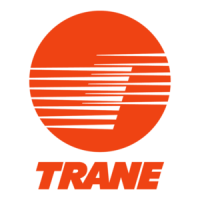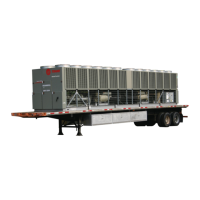24 RTAC-SVX002A-EN
Installation Mechanical
Isolation and Sound Emission
The most effective form of isolation is
to locate the unit away from any sound
sensitive area. Structurally transmitted
sound can be reduced by elastomeric
vibration eliminators. Spring isolators
are not recommended. Consult an
acoustical engineer in critical sound
applications.
State and local codes on sound
emissions should always be
considered. Since the environment in
which a sound source is located affects
sound pressure, unit placement must
be carefully evaluated. Sound power
levels for Trane air-cooled Series R®
chillers are available on request.
ISOLATOR LOCATION
USE W/ X28050008000
1/2"-13 UNC LOCKNUT
Units with 2 compressors
Units with 3 or more compressors
Fig. III-04 – Unit Isolator Locations
Ton Efciency Hz Insulator
Quantity
Cantidad
140 STD 60 X101403 1503 8
High 60 X101403 1503 8
155 STD 60 X101403 1503 8
High 60 X101403 1503 8
170 STD 60 X101403 1503 8
High 60 X101403 1503 8
185 STD 60 X101403 1503 8
High 60 X101403 1503 10
200 STD 60 X101403 1503 8
High 60 X101403 1503 10
225 STD 60 X101403 1503 10
High 60 X101403 1503 10
250 STD 60 X101403 1503 10
High 60 X101403 1503 10
275 STD 60 X101403 1503 10
High 60 X101403 1503 10
300 STD 60 X101403 1503 10
High 60 X101403 1503 10
350 STD 60 X101403 1503 10
For maximum isolation effect, isolate
water lines and electrical conduit. Wall
sleeves and rubber isolated piping
hangers can be used to reduce the
sound transmitted through water piping.
To reduce the sound transmitted
through electrical conduit, use exible
electrical conduit.

